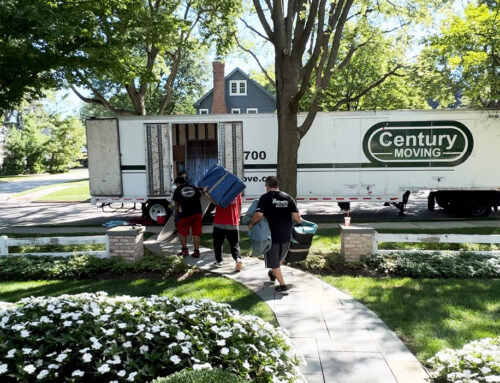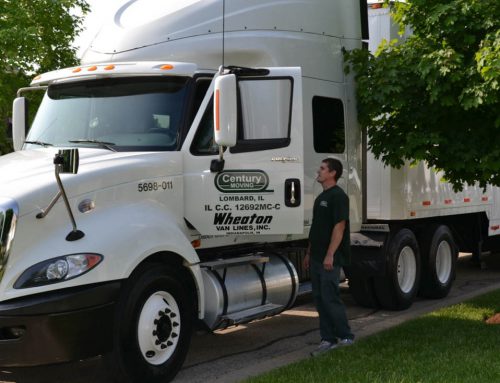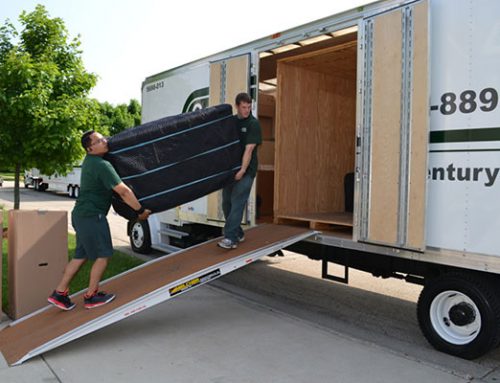June 17, 2021
Moving with Children, from Infants to Teenagers
Many families planning to complete a move this summer so the kids are all ready to start school in the fall. Whether you’re moving with an infant or preschooler, or children who are elementary, middle-school or high-school age, there are different challenges to be solved.

If you’re a parent considering a move, we understand what you are feeling. Moving with children, of any age, is stressful, and each age holds its own special challenges. From babies to young adults, children typically thrive on routine and familiarity. Often, so do adults! So, while you may be feeling just as apprehensive and anxious about the upcoming move, you have the added responsibility of trying to put your children at ease about the move too.
At Century Moving, we’ve seen the excitement, tears, and worry that comes with moving and we can assure you that the actual transfer of your belongings is in good hands. Instead, concentrate on the needs of your family and children. To help, we’ve put together this brief guide of compiled tips, tricks, and helpful advice when it comes to moving the kiddos. Take a break from packing, grab a lemonade, and read on…
Moving with Babies, Toddlers, Preschoolers
Kids under the age of five do not fully understand the changes occurring, so explanations are in order. Try to see the move through their eyes. For example, children who are moving to a home sight unseen may worry that the home may not be able to accommodate their belongings or even that their new house may not have a bathroom. Although moving with children of this age is generally the easiest of the age brackets, there are many things you can do to help make the move go more smoothly.

- Use books or stories that explain what moving is. Answer all questions they may have about the process, and what it will be like once you are there.
- Involve them in the packing. Explain why you are packing and where the boxes are going (not the garbage). Allow them to help as much as possible and to say goodbye to items as you close the box.
- Seek help. Hire a babysitter or have a family member watch the children on move day and maybe even longer as you get everything all settled in. The process will go more quickly without the children underfoot and it may give them something to look forward to during the move.
- Unpack their room first. The sooner they see their old toys and can play with them again, the sooner they will recover a sense of normalcy.
- Delay buying new furniture. After the move, allow them to keep their old bedroom furniture in the new house until they have settled in with the change of the move. Then you can consider new furniture before purchasing new.
*Chicago Suburban Highlights for this age: The Western suburbs are a magnet for young couples and families. They were full of Forest Preserves with plenty of great playgrounds and activities for the younger set, along with top-rated school districts.
Moving with School-Age Children
While some children in this age group can be open to or excited for moving, others may be resistant. If they are leaving friends or school behind, take time for meaningful goodbyes. It’s important not to underestimate the emotional impact moving has on kids, but there are ways to help weather the storm.
- Involve them in the move. Give them the responsibility of packing, picking their new room, and what to keep and what to donate, etc.
- If they put up a fight, listen. If they are sad, feel the emotion but focus on positives. Let them know it is ok to have feelings, and you will do all you can to make the move a good one for them.
- Get them acclimated to the new school as soon as possible. Ensure there are no glitches by anticipating the new school’s needs, i.e., transcripts, medical records. Research and set up anything they will need to continue their old life in their new location: sports teams, church youth groups, etc.
- Use technology to keep in touch with old friends. Set up an email, Facebook, or Zoom for your child to communicate with friends and neighbors after the move. Let them know they can still remain friends even after a move.
- Make a project. Get out the glue and crayons. Enlist their help on new décor for the new home.
*Suburban Highlights for this Age: The Northern suburbs are home to several family friendly homes with charming downtown areas that are a mere train ride away from Chicago. There are plenty of cultural attractions, a rich history, and beautiful parks to be found, along with the charm of rural living with a mix of urban life.
Moving with Teenagers and Young Adults
 Of all the age groups, teens are most likely to react negatively to the idea of moving. Typically, they are leaving behind friends, school commitments and activities (teams, extracurriculars, school dances, etc.), established or new love interests, and possibly the home they grew up in. Moving with teenagers is a challenge, but with patience and support, your teen can learn to see the move as a learning opportunity and a step towards a bright future. Here are some ways you can help them.
Of all the age groups, teens are most likely to react negatively to the idea of moving. Typically, they are leaving behind friends, school commitments and activities (teams, extracurriculars, school dances, etc.), established or new love interests, and possibly the home they grew up in. Moving with teenagers is a challenge, but with patience and support, your teen can learn to see the move as a learning opportunity and a step towards a bright future. Here are some ways you can help them.
- Involve your teen in the house hunt. They can check out the schools, malls, and restaurants, and help you choose a house that looks like home to them.
- Focus on the positives. Maybe you are purchasing a bigger house, adding a yard, within walking distance of hot spots, or moving to a town full of teen-centered activities. Be sure to highlight if the new community offers a school with different extracurriculars, sports teams, etc. in line with their specific interests.
- Consider a delay. If your move is planned in the spring semester or later in the year, consider allowing your teen to finish out the year at their old school, especially if they are a high school senior. Perhaps they could stay with a friend or family member so they may close out their year smoothly.
- Throw a going away party. Giving them a project, like planning a party, will help them cope and allow them the opportunity to see all their friends/family in one place.
- Keep the mood light. Let them pack their own things and suggest selling items no longer in use. They can use the money to purchase furnishings for their new bedroom.
*Suburban Highlights for Teens: The southern Chicago suburbs are packed with things to do, with a great mix of urban/suburban. Chicago is just miles away, where teen draws such as concert venues, museums, parks and the trendiest shopping are easily reached by public transportation.
No matter what ages your children are, use the time to move as a time to grow closer as a family while teaching the valuable lesson that change is part of life. Stepping out of your comfort zone is part of growing up, and while not always comfortable, choosing the right next house and the right mover too, can make all the difference in the complete experience. Our motto is “our family moving families sine 1976.” We are in your corner to help your children feel at home as soon as they can. If you’re ready to move with children, give us a call today at 630-889-2700.
June 17, 2021
Moving with Children, from Infants to Teenagers

Many families planning to complete a move this summer so the kids are all ready to start school in the fall. Whether you’re moving with an infant or preschooler, or children who are elementary, middle-school or high-school age, there are different challenges to be solved.

If you’re a parent considering a move, we understand what you are feeling. Moving with children, of any age, is stressful, and each age holds its own special challenges. From babies to young adults, children typically thrive on routine and familiarity. Often, so do adults! So, while you may be feeling just as apprehensive and anxious about the upcoming move, you have the added responsibility of trying to put your children at ease about the move too.
At Century Moving, we’ve seen the excitement, tears, and worry that comes with moving and we can assure you that the actual transfer of your belongings is in good hands. Instead, concentrate on the needs of your family and children. To help, we’ve put together this brief guide of compiled tips, tricks, and helpful advice when it comes to moving the kiddos. Take a break from packing, grab a lemonade, and read on…
Moving with Babies, Toddlers, Preschoolers
Kids under the age of five do not fully understand the changes occurring, so explanations are in order. Try to see the move through their eyes. For example, children who are moving to a home sight unseen may worry that the home may not be able to accommodate their belongings or even that their new house may not have a bathroom. Although moving with children of this age is generally the easiest of the age brackets, there are many things you can do to help make the move go more smoothly.

- Use books or stories that explain what moving is. Answer all questions they may have about the process, and what it will be like once you are there.
- Involve them in the packing. Explain why you are packing and where the boxes are going (not the garbage). Allow them to help as much as possible and to say goodbye to items as you close the box.
- Seek help. Hire a babysitter or have a family member watch the children on move day and maybe even longer as you get everything all settled in. The process will go more quickly without the children underfoot and it may give them something to look forward to during the move.
- Unpack their room first. The sooner they see their old toys and can play with them again, the sooner they will recover a sense of normalcy.
- Delay buying new furniture. After the move, allow them to keep their old bedroom furniture in the new house until they have settled in with the change of the move. Then you can consider new furniture before purchasing new.
*Chicago Suburban Highlights for this age: The Western suburbs are a magnet for young couples and families. They were full of Forest Preserves with plenty of great playgrounds and activities for the younger set, along with top-rated school districts.
Moving with School-Age Children
While some children in this age group can be open to or excited for moving, others may be resistant. If they are leaving friends or school behind, take time for meaningful goodbyes. It’s important not to underestimate the emotional impact moving has on kids, but there are ways to help weather the storm.
- Involve them in the move. Give them the responsibility of packing, picking their new room, and what to keep and what to donate, etc.
- If they put up a fight, listen. If they are sad, feel the emotion but focus on positives. Let them know it is ok to have feelings, and you will do all you can to make the move a good one for them.
- Get them acclimated to the new school as soon as possible. Ensure there are no glitches by anticipating the new school’s needs, i.e., transcripts, medical records. Research and set up anything they will need to continue their old life in their new location: sports teams, church youth groups, etc.
- Use technology to keep in touch with old friends. Set up an email, Facebook, or Zoom for your child to communicate with friends and neighbors after the move. Let them know they can still remain friends even after a move.
- Make a project. Get out the glue and crayons. Enlist their help on new décor for the new home.
*Suburban Highlights for this Age: The Northern suburbs are home to several family friendly homes with charming downtown areas that are a mere train ride away from Chicago. There are plenty of cultural attractions, a rich history, and beautiful parks to be found, along with the charm of rural living with a mix of urban life.
Moving with Teenagers and Young Adults
 Of all the age groups, teens are most likely to react negatively to the idea of moving. Typically, they are leaving behind friends, school commitments and activities (teams, extracurriculars, school dances, etc.), established or new love interests, and possibly the home they grew up in. Moving with teenagers is a challenge, but with patience and support, your teen can learn to see the move as a learning opportunity and a step towards a bright future. Here are some ways you can help them.
Of all the age groups, teens are most likely to react negatively to the idea of moving. Typically, they are leaving behind friends, school commitments and activities (teams, extracurriculars, school dances, etc.), established or new love interests, and possibly the home they grew up in. Moving with teenagers is a challenge, but with patience and support, your teen can learn to see the move as a learning opportunity and a step towards a bright future. Here are some ways you can help them.
- Involve your teen in the house hunt. They can check out the schools, malls, and restaurants, and help you choose a house that looks like home to them.
- Focus on the positives. Maybe you are purchasing a bigger house, adding a yard, within walking distance of hot spots, or moving to a town full of teen-centered activities. Be sure to highlight if the new community offers a school with different extracurriculars, sports teams, etc. in line with their specific interests.
- Consider a delay. If your move is planned in the spring semester or later in the year, consider allowing your teen to finish out the year at their old school, especially if they are a high school senior. Perhaps they could stay with a friend or family member so they may close out their year smoothly.
- Throw a going away party. Giving them a project, like planning a party, will help them cope and allow them the opportunity to see all their friends/family in one place.
- Keep the mood light. Let them pack their own things and suggest selling items no longer in use. They can use the money to purchase furnishings for their new bedroom.
*Suburban Highlights for Teens: The southern Chicago suburbs are packed with things to do, with a great mix of urban/suburban. Chicago is just miles away, where teen draws such as concert venues, museums, parks and the trendiest shopping are easily reached by public transportation.
No matter what ages your children are, use the time to move as a time to grow closer as a family while teaching the valuable lesson that change is part of life. Stepping out of your comfort zone is part of growing up, and while not always comfortable, choosing the right next house and the right mover too, can make all the difference in the complete experience. Our motto is “our family moving families sine 1976.” We are in your corner to help your children feel at home as soon as they can. If you’re ready to move with children, give us a call today at 630-889-2700.




























